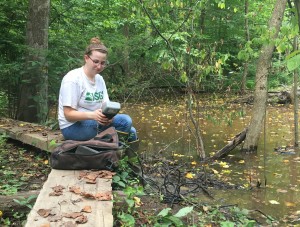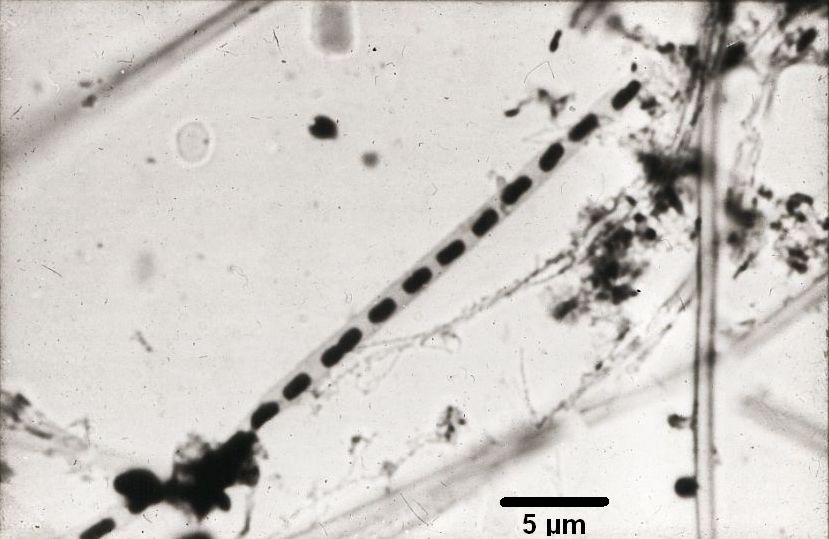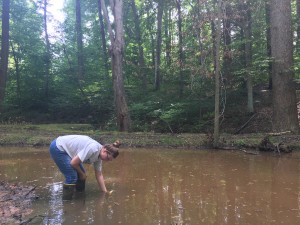
SERC intern Lauren Mosesso takes a water quality reading (Photo: Emily Li/SERC)
by Emily Li
One year ago, a team of scientists at the Smithsonian Environmental Research Center set out to restore a stream running through its campus in Edgewater, Md. No one ever said it would be simple.
At first glance, the restoration of Muddy Creek seems to be a closed case. Before the project began, the creek’s severely eroded banks were disconnected from its floodplains, turning the stream into a raging river during storms that stripped nutrients from the system and dumped them in the Chesapeake Bay. Now, after a facelift in January, the creek is nearly unrecognizable. Its gentle banks cradle the wide, slow-moving stream littered with leaves, ferns, and an abundance of other plant life. Choruses of croaks fill the air, accompanied by the hum of insects, bird chatter, and the occasional splash of frogs retreating into the cloudy water.
But another layer of mystery is clouding the waters. A mat of red Leptothrix bacteria coats some sections of the site, leading SERC senior scientist Dr. Thomas Jordan and his colleagues to ask a host of new questions. Are the bacteria harmful to the ecosystem, or an important part of the food web? Are they a short-term phenomenon or a permanent fixture to the stream? Exactly how much area do they cover? One SERC intern is hoping to find out.
The new bacteria on the block

A chain of Leptothrix cells in a sheath, taken with a light microscope (Photo: Brudersohn)
One clue in the ongoing investigation comes from another species often found alongside the bacteria: bloodworms. Because bloodworms are tolerant of low oxygen conditions, they’re often found in streams with low dissolved oxygen concentrations, which could indicate that the bacteria are taking oxygen out of the water. The bacteria’s rusty coating of stream surfaces also prevents some plants from growing where they’d otherwise be able to, which is bad news for animals with a taste for algae.
Given that lead, Lauren Mosesso—an intern in SERC’s Nutrient Lab this summer—is working to determine the oxygen demand of the bacteria making Muddy Creek blush, in the hope of connecting some of the dots between the bacteria and restoration.
To do this, Mosesso buried nine chambers beneath the water’s surface: three control chambers above the site, where the bacteria are not present, and the rest in various places along the 1476-foot restoration. The chambers are then left uncapped in the water, allowing them to harbor the same organisms found naturally in the stream.
Another hint helped them figure out where exactly to place the chambers—the bacteria’s color. The red hue is a characteristic marker of iron oxidation, the same process that creates rust. And as the name suggests, iron oxidation requires oxygen, which could help explain the bacteria’s oxygen demand. With this in mind, Mosesso targeted sites along the restoration where she knew iron-rich groundwater upwelling was occurring, hoping to catch the bacteria red-handed.

Intern Lauren Mosesso surveys the chamber from one of her sites (Photo: Emily Li/SERC)
Falling for field work
When it’s time to survey the chambers, Mosesso uses a waterproof Yellow Springs Instrument (YSI for short) fastened onto the chambers in an airtight fit, and takes a number of measures of the isolated ecosystem. The number she’s interested in is the difference in dissolved oxygen after 10 minutes of the organisms being trapped in the chamber, because she knows the bacteria are busy oxidizing iron.
“This water is maybe around 0.7 to 1 milligrams per liter. Within four minutes, it’s dropped to 0.2, which is very fast,” Mosesso explained. “We’re expecting the metabolic rates to be much faster here since the bacteria’s here in such high amounts, and it’s demanding a lot of oxygen.”
What remains a mystery is why the bacteria are doing it. It might be that high oxygen levels are poisonous to the bacteria, so iron oxidation is way of altering the environment to their benefit—but the “why” question is for another time. For now, Mosesso is investigating the “what,” and the preliminary results already look promising. But Muddy Creek hasn’t made the experiment easy. From the makeshift wooden bridges between sites to the thick mud, the ecosystem seems like a tumble waiting to happen. In fact, Mosesso hasn’t needed to wait long at all.
“I’ve fallen multiple times—yes, like completely wiped out,” she said as she struggled to lift her knee-high boots from the water, YSI in hand. “Sometimes I chant to myself, ‘I will not fall, I will not fall,’ and it works.”
The chip on Muddy Creek’s shoulder

Muddy Creek post-restoration (Photo: Emily Li/SERC)
While the daily chance of getting mud in her mouth varies, one thing’s for sure—Mosesso’s research is worth the face-plants and long hours in deer fly heaven. She’s also working on a similar project using two long-term probes to reveal the metabolism of the entire stream. If she can determine the bacteria’s oxygen demand, it might be a key piece in the puzzle of effective stream restoration.
It could be that the woodchips used to fill in Muddy Creek’s eroded banks are a useful source of carbon for these microbes. Along with Maryland’s iron-rich groundwater, both factors may help make the restoration site a bacteria hotspot. It’s an attractive idea, considering the only other site where Mosesso knows the bacteria are an issue is another stream restoration in Maryland. But for now, it’s just a possibility—the lab still has more questions than answers. Mosesso stresses that her research will only answer a small part of a larger question specific to the restoration at Muddy Creek.
“Because stream restoration is relatively new, we’re trying to figure out what’s good for certain systems and what’s good for other systems,” she says.
Photo of Leptothrix bacteria used under Creative Commons license from Brudersohn.


Possible clue: your description sounds very similar to the coating found on many streams that run through golf courses.